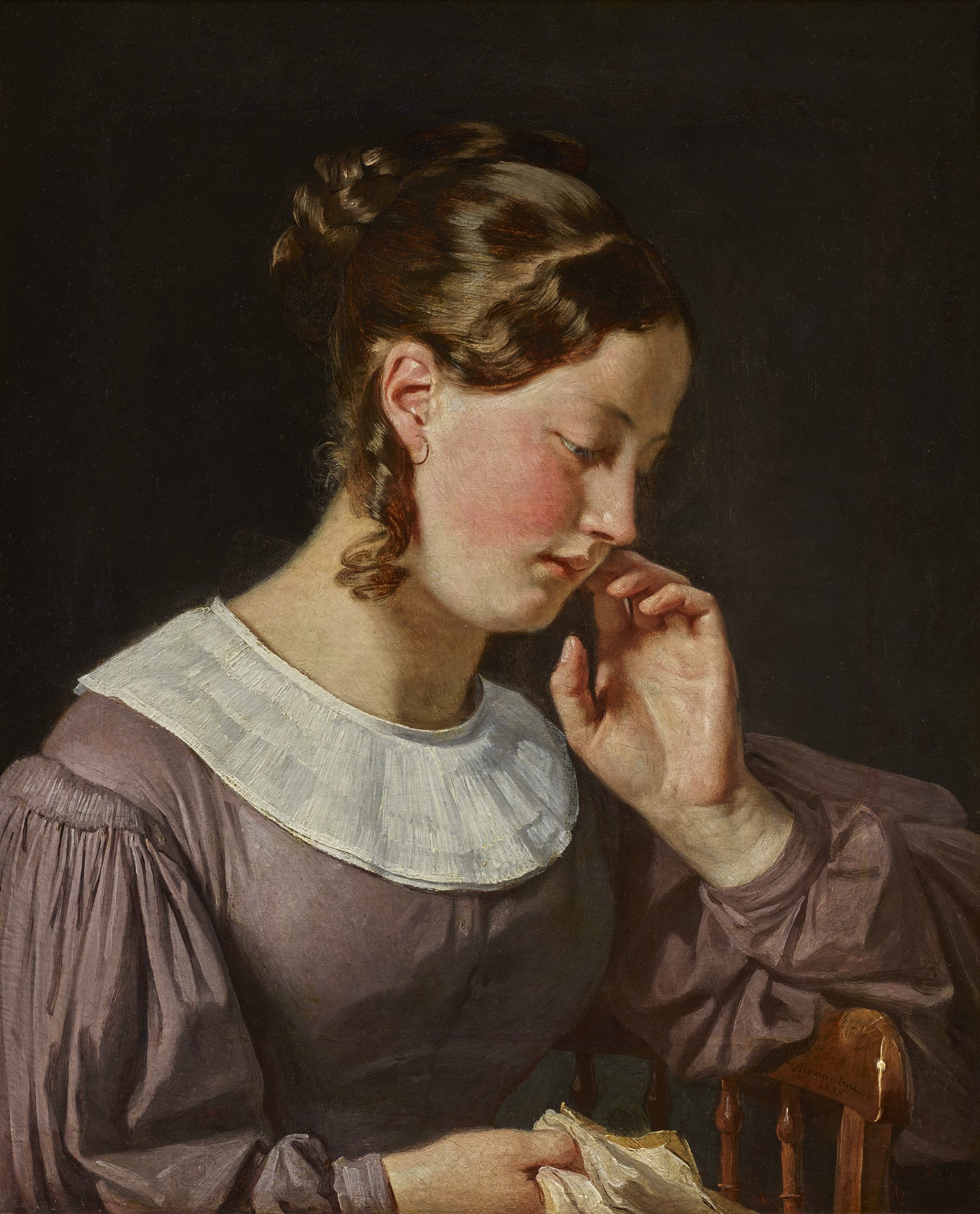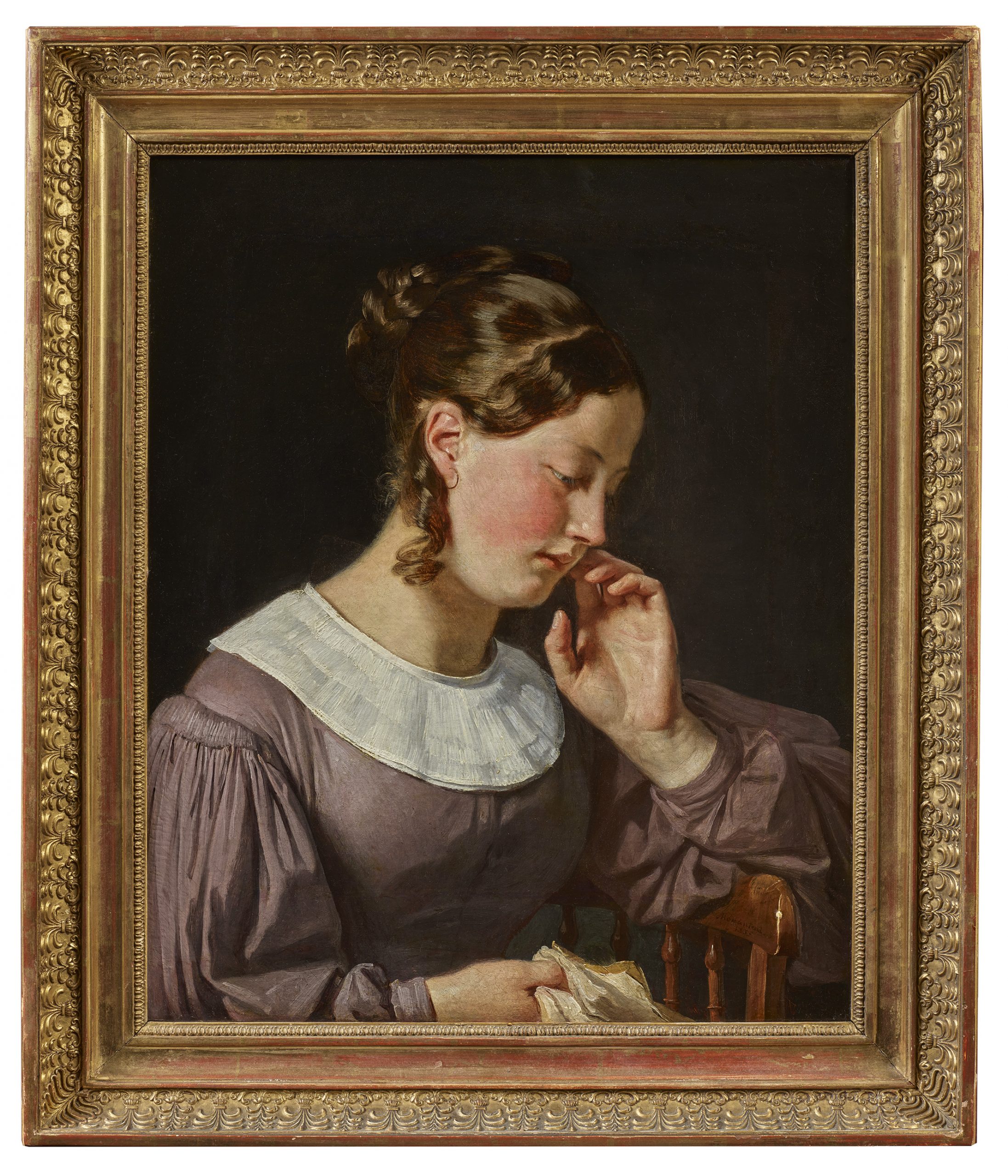(1785-1860)
Portrait of a young girl
Oil on canvas
56 x 45,7 cm / framed : 75,5 x 64 cm
Signed and dated lower right : Monanteuil 1835
Haro seal on the frame
Provenance : Private collection, United States
The wonderful sensitivity of a young woman from the provinces lost in a dream born of her readings expressed by a reduced palette of blacks, plum-rich greys and white subtly modulated in the manner of the seventeenth century Dutch painters : that is all the art of Monanteuil one of the most unknown artists of his time halfway between classicism and romanticism revealed by a soft and engaging image at the same time.
The model’s half-closed eyes, the delicacy of her gesture evoke a world of silence and interiority. The details of the curls in her hair, the creamy material in her collar, the virtuosity of the treatment of the folds of her clothing tell us all the care taken by the artist to realize this portrait full of intimacy which we imagine quite well being that of a close one. Unlike some of his works which are sometimes quite crude in their realism Monanteuil here rediscovers the ideal of beauty he had known in the workshop of Girodet who died ten years earlier and who left a mark on him with his technical requirements and his knowledge of beautiful images for the rest of his career.
Jean-Jacques Monanteuil was born in Mortagne-au-Perche in the Orne department into a relatively modest but locally recognized family: his father of Champagne origin was a merchant who took part in revolutionary events by becoming a member of the municipal board. The future artist shows early
dispositions for drawing enough to be noticed by Louis-Joseph Poissonnier de Prulay (1762-1817) son of the doctor of Louis XV and owner of the castle of the same name at the gates of Mortagne. Thanks to him the young Monanteuil received his first artistic training at the Ecole Centrale de l’Orne before leaving for Paris in 1800 to perfect his education and launch his career.
Monanteuil found a place among the Petits-Augustins in the prestigious studio of the painter of history Anne-Louis Girodet (1767-1824) former student of David (1748-1825). The young painter receives in this studio (a real collector’s cabinet) an ambitious classical teaching thanks to the copy of the antique or the works of the Louvre without forgetting the anatomical studies. After a brief stay at the Ecole des Beaux-Arts Monanteuil returned to his master of whom he became a very close collaborator. Indeed he served as a model for Girodet for the figure of young Chactas in one of his masterpieces: Les Funérailles d’Atala, 1808, kept at the Louvre.
Monanteuil’s reputation grew gradually thanks to his talent as a lithographer which he put to the service of Girodet. His most important achievement in this field is the lithography of illustrations of his Enéide made between 1811 and 1824. The collection was however published only between 1825 and 1827, because Girodet’s premature death in 1824 forced Antoine Claude Pannetier (1772-1859), another lithographer of the project to complete the illustrations for the series. After this episode Monanteuil then recognized in the Parisian artistic milieu worked as a lithographer for Pierre-Narcisse Guérin (1774-1833) and Antoine-Jean Gros (1771-1835).
Monanteuil’s established reputation means that he is exhibiting more and more works at the Salon. Without attracting the laurels of the first places it nevertheless receives praise from critics. He took advantage of this new status since he was now asked to make portraits of some personalities such as the Duchess of Berry (1798-1870) or Châteaubriand (1768-1848).
After a few years his subjects change and his inspirations evolve. Now his art looks at the daily and picturesque life of workers, peasants and sailors. After finally settling in Alençon in 1828 a real fascination for the wild and rustic side of Brittany drives him to travel.
Back in his native region the painter’s reputation allows him to become the portraitist of the bourgeoisie and local notables thanks to a unique style: an intimate realism almost picturesque whose anatomical and physionomic lines as well as the sense of the construction of the bodies betray a prestigious neoclassical formation. This synthesis of movements and artistic concerns make Monanteuil a singular and recognized painter.


